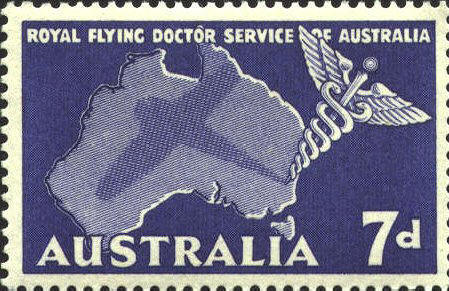|
Australia 305

The "proper" medical symbol
is the Rod of Aesculapius (or Aesclepios in Greek) with a single
serpent entwined around a cypress branch.

It is used by the
American Medical Association, the U.S. Air Force Medical Service and
the Australian Army Medical Corps, among others, while the U.S. Army
Medical Corps, the U.S. Navy Pharmacy Division, the Public Health
Service, the Australian Medical Corps. and the Queensland Government Ambulance Service use the
Caduceus of Hermes (Mercury) with two entwined serpents. Hermes was the messenger
of the gods, the god of trickery, wealth and death.

The Royal Flying Doctor Service began in 1928 in Queensland as the
Aerial Medical Service. It was expanded to cover all of Australia and
supported by the Australian government in 1932, and it was re-named the
Australian Aerial Medical Service. In 1942 it was re-named again as
the Flying Doctor Service, with Royal added in 1955.
The stamp was issued in
1957. While the Rod of Aesculapius would have been a proper symbol to
appear on the stamp, no doubt the Caduceus was chosen because of the
wings.


 |
